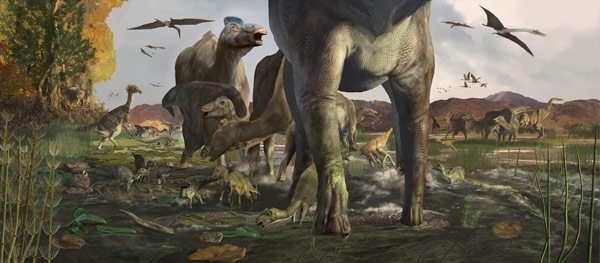Distance Learning
- Grade Level:
- Lower Elementary: Pre-Kindergarten through Second Grade
- Subject:
- Science

Denali was created to protect wild animals, but it also protects some of the most expansive and significant dinosaur trackways in the world. During this Distance Learning program, students travel back in time with a ranger to learn about how the predator-prey interactions of Denali’s dinosaurs mirror those of wild animals in Denali today. By comparing animal dynamics in present-day and Cretaceous Denali to a natural area near their home, students discover that we can use our knowledge from different locations and times to understand the interconnections of the natural world.
Program Length and Grade Range
This program is 30 minutes long for students in grades K–2 and 50 minutes long for students in grades 3–5.
How to Participate
Denali's Distance Learning programs are a fun and interactive way for our education rangers to visit your classroom for free!
Our Distance Learning presentations are available from November 1 through March 31 annually (with breaks around some major holidays). Registration begins on October 15th annually. Spaces are limited and registration is handled on a first-come, first-served basis.
You will find the link to our Distance Learning Registration Form on Denali's Distance Learning homepage.
Denali's Dinosaurs—Teacher's Guide
Program Objectives
Students will:
- Learn that Denali National Park and Preserve is a protected area in the subarctic where predator-prey relationships take place without human interference, just like they did in the time of dinosaurs.
- Explore how Denali and many other natural places are homes for wild animals, and also hold clues to the past such as fossils of wild animals that used to live there.
- Compare the diet, physical features, and social habits of animals that live in Denali today (wolves and caribou) and dinosaurs that lived here 70 million years ago (hadrosaurs and troodontids).
- (Grades 3–5 only) Learn about the types of fossils that have been found in Denali including bones, tracks, skin impressions, and coprolites. Make the connection that modern animals leave behind similar clues every day.
- (Grades 3–5 only) Discover that Denali’s climate has changed since the Cretaceous, and explore whether the environment may have changed over time near where the students live as well.
- (Grades 3–5 only) Discuss whether the animals that live in Denali may change as the climate warms, and consider the value of protected areas in a changing environment.
Next Generation Science Standards Addressed
- Grades K–2: K-LS1-1, 1-LS3-1, 2-LS4-1 3-LS3-2
- Grades 3–5: 3-LS4-1, 3-LS4-3; 3-LS4-4; 4-LS1-1, 5-ESS3-1
Vocabulary and Concepts Covered
-
All grades: Denali National Park and Preserve, subarctic environment, paleontologist, fossil, caribou, wolf, herbivore, carnivore, predator, prey, Cretaceous, hadrosaur, pterosaur, troodontid.
- Grades 3–5: Trace fossil, mold and cast fossil footprints, skin impression, coprolite, environmental change.
Before the Distance Learning Program
-
Assign or read aloud the Denali's Dinosaurs student reading and the Denali Overview for Students.
-
During the program, the ranger will ask you (the teacher) to name a natural area near where you live that most of your students have visited and can easily visualize. Throughout the program, the ranger will ask your students to compare animal dynamics in Denali’s present and past to parallel dynamics in that natural area. The natural area that you select should be a very familiar place like a town or state park, or a nearby woods or undeveloped area, where animals behave relatively naturally. Thank you for thinking about which natural area you will be most meaningful to your students prior to the program!
-
We love chatting with students about Denali! Encourage your learners to think of questions to ask the ranger. We usually have time at the end of a program to answer questions, and we're happy to answer your class's top four overflow questions via e-mail.
- Make sure you have a Zoom link at least a week ahead of time.
During the Distance Learning Program
-
Materials needed: Name of a familiar natural area near you
- The teacher is responsible for classroom management during the program. This includes calling on students throughout the program and helping to ensure that their answers and comments are understood by all. The teacher is also responsible for facilitating questions at the end of the program.
After the Distance Learning Program
-
Email us your questions, feedback, or an evaluation form. We love hearing ways that we can continue to improve our programs!
- Post-activity suggestions:
- Grades K–2: Have your students draw pictures of animals that they learned about during the program, such as caribou and wolf from Denali’s present, hadrosaur and troodontid from Denali’s past, or predator and prey species from the natural area near you. Ask them to highlight and label the adaptations that help the animals to survive and obtain food in their environment.
- Grades 3–5: Same ask K–2, plus have your students draw the clues that those animals might leave behind. Ask them to write about how paleontologists put together clues from the past and present to understand the environments in which animals live and how they change through time.
Last updated: April 1, 2022
